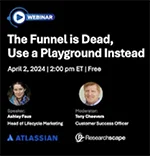 Audrey Merritt |
Is B2B marketing boring? If you consume it — and we all do — you already know the answer.
And yet, so many B2B companies insist their audience is different. “Our targets respond to facts, not emotional appeals.” “Our consumers want to see a feature list, not a broad statement about benefits.” And the dreaded: “We can’t use humor. It will undermine our credibility.”
It’s not surprising that entrepreneurs and developers who’ve poured blood, sweat and middle-of-the-night-meltdown tears into building a remarkable solution want to believe their product will sell itself based purely on technical merits. If that were true, however, the best technology would automatically rise to the top of the market. And that’s not how it works.
More than 10 years ago, my partner and I co-founded an agency on the belief that B2B buyers are humans who want to connect emotionally, and that most existing B2B marketing was missing the mark. Recently, we decided to get data to back up our claims. So, we commissioned a survey, conducted by Propeller Insights, of more than 1,100 B2B purchasing decision makers.
The results weren’t a surprise. But they were impressive:
• 48 percent said they find the advertising directed at them to be boring.
• 49 percent feel most websites for business products and services aren’t as interesting and creative as consumer websites.
• 82 percent wish B2B advertising could have more of the creativity associated with B2C advertising.
When nearly half your market uses a word like “boring,” it may be time to pay attention. But this issue isn’t just about whether or not people enjoy B2B marketing; it’s about whether B2B marketing works. And that’s where things get really interesting: 78 percent of respondents said that “sometimes,” “rarely” or “never” does the B2B advertising they see prompt them to take a next step towards making a purchase.
And here’s the most striking news of all: 81 percent said they’d be able to make better buying decisions if B2B advertising did a better job of engaging them.
In other words, your customers want to be educated; they know their buying decisions are compromised when they aren’t. But they won’t get to the “what” if you don’t give them a reason to pay attention first.
So, what’s the next step that you, as a marketer, can take? First, be clear about your messaging hierarchy. You need to explain what you do, but that should never be the first interaction your audience has with your brand. Instead, they should see something that breaks through the noise to capture their interest and, ideally, make them feel something.
When you’re strategizing around creative development, pose emotional questions to get inside the hearts of your customers. What are their biggest challenges? What do they think they want? What do they really need? What do they dream about? If you can connect with feelings instead of thoughts, you’ve reached the place where decisions are made.
And you don’t have to guess; you can go to customer voices for inspiration. So often, the ways your customers talk about your product will be less expected than the more typical phrases companies tend to fall back on. You can mine interviews, case studies, social media comments — whatever your customers are saying — for usable nuggets.
Finally, here’s an exercise we do at our agency. In our brand strategy process, we pull together the topline messaging from all the companies competing for mindshare in a client’s space. It’s always ugly. Every single business is using the same words, over and over. When we see it laid out like that, we’re forced to find new language and a new angle so we can stand out. And that can inspire refreshing visual approaches, too.
Boring marketing is bad marketing. We’ve always known it was true, and now that we have the data to prove it, we can be more motivated than ever to deliver the unexpected.
***
Audrey Merritt is a founding partner at WHM Creative.


 Abandon traditional content plans focused on a linear buyer progression and instead embrace a consumer journey where no matter which direction they travel, they get what they need, stressed marketing pro Ashley Faus during O'Dwyer's webinar Apr. 2.
Abandon traditional content plans focused on a linear buyer progression and instead embrace a consumer journey where no matter which direction they travel, they get what they need, stressed marketing pro Ashley Faus during O'Dwyer's webinar Apr. 2. Freelance marketers and the companies that hire them are both satisfied with the current work arrangements they have and anticipate the volume of freelance opportunities to increase in the future, according to new data on the growing freelance marketing economy.
Freelance marketers and the companies that hire them are both satisfied with the current work arrangements they have and anticipate the volume of freelance opportunities to increase in the future, according to new data on the growing freelance marketing economy. Home Depot's new attempt to occupy two market positions at once will require careful positioning strategy and execution to make it work.
Home Depot's new attempt to occupy two market positions at once will require careful positioning strategy and execution to make it work. Verizon snags Peloton Interactive chief marketing officer Leslie Berland as its new CMO, effective Jan. 9. Berland succeeds Diego Scotti, who left Verizon earlier this year.
Verizon snags Peloton Interactive chief marketing officer Leslie Berland as its new CMO, effective Jan. 9. Berland succeeds Diego Scotti, who left Verizon earlier this year.  Norm de Greve, who has been CMO at CVS Health since 2015, is taking the top marketing job at General Motors, effective July 31.
Norm de Greve, who has been CMO at CVS Health since 2015, is taking the top marketing job at General Motors, effective July 31.


 Have a comment? Send it to
Have a comment? Send it to 
No comments have been submitted for this story yet.